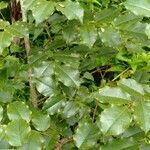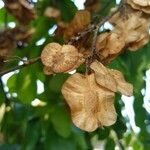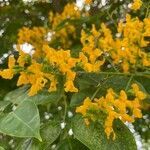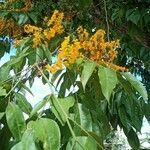Trees, 15-25 m tall. Bark grayish. Leaves 15-30 cm; stipules early caducous; petiolules 4-7 mm; rachis and petiolule glabrous; leaflets 5-7(-11), ovate-elliptic, 5-11 × 3.5-5.5 cm, thinly papery, both surfaces glabrous, veins slender, lateral veins 6-8 pairs, base truncate, margin entire, apex shortly acuminate. Inflorescence a raceme or panicle, mostly axillary, rarely terminal, 10-18 cm, puberulent. Flowers 1-1.5 cm; bracteoles 2, linear-oblong, at base of calyx. Pedicel 7-10 mm, slender. Calyx campanulate, 4-6 mm, appressed brown silky; teeth broadly triangular, ca. 1 mm, 2 larger than others. Corolla yellow; petals long clawed; standard ovate-orbicular to oblong, crisped at margin; wings oblong, ca. as long as standard; keel narrowly oblong, smaller than wings. Stamens 10, diadelphous (9+1), sheath 8-9 mm, vexillary filament free to base, filaments of varying heights; anthers versatile. Ovary shortly stipitate, oblong, 7-8 mm, densely pubescent; ovules 2; style curved; stigma minute. Legume orbicular, 4-4.5 × 3.5-4.5 cm, shortly stalked, flat, slightly hairy and reticulate opposite seed, 1-seeded, broadly winged around margin, wing to 2 cm wide. Seed brownish, reniform, narrow and oblique. Fl. Mar-Apr, fr. Apr-May.
More
A medium sized evergreen tree. It grows to 27-30 m high and spreads to 4 m across. The stem is erect and stout. It branches. The trunk is 60-80 cm across. The leaves are compound with an odd number of leaflets. These are oval. The leaves are 20-45 cm long. The leaflets are 6-10 cm long by 3-5 cm wide. It can lose its leaves. The flowers are yellow and woolly. The sepals forming the outer ring of the flowers are brown. The flowers occur as many in a branched flower arrangement. The flowers are bell shaped. The fruit are round pods. These are 5 cm across. They can have 1 or 2 seeds but sometimes 4.
A tropical plant. It is native to tropical Asia. It does best in rich, moist, well-drained soils. It needs a protected sunny position. It is damaged by drought and frost. It is often found in coastal swamps along tidal creeks. It usually grows in areas with an annual average temperature of 22-32°C. It can grow in soils with a pH of 4.0-7.4. It suits hardiness zones 11-12. In Yunnan.
More
A widespread tree found in lowland primary and some secondary forest, mainly along tidal creeks and rocky shores at elevations up to 750 metres. Also found in beach forest, on coral sand and on rocky shores.






